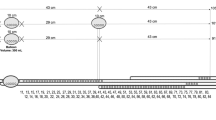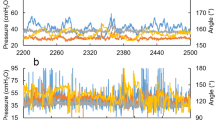Abstract
PURPOSE: Paradoxical sphincter reaction is frequently found in constipated patients but sometimes also in incontinent patients and in asymptomatic subjects. Its significance in defecation disorders has, therefore, been debated. The aim of the present study was to investigate whether paradoxical sphincter reaction is influenced by rectal filling volume. PATIENTS AND METHODS: Eighteen patients with defecation disorders and paradoxical sphincter reaction shown by electromyography were reinvestigated with an extended electromyographic investigation while in the lying position and while in the sitting position, with 50-ml, 100-ml, and 150-ml water-filled rectal balloons. RESULTS: All 18 patients showing paradoxical sphincter reaction in the first investigation also showed the reaction at the second investigation in the lying position with a 0-ml volume of rectal contents. In the sitting position, with a volume of 150 ml of rectal contents, the increase in electromyographic activity disappeared in seven patients (39 percent) and no longer showed paradoxical sphincter reaction. Electromyography showed decreased activity in one patient and unchanged activity in six patients during straining. A closing reflex was seen after completed straining in all of these seven patients. CONCLUSIONS: The present study demonstrates that paradoxical sphincter reaction diagnosed by electromyography is influenced by the rectal filling volume and might diminish when the rectum is filled with contents. The conventional electrophysiologic technique in the diagnosis of paradoxical sphincter reaction might, therefore, overdiagnose this condition.
Similar content being viewed by others
References
Porter NH. A physiological study of the pelvic floor in rectal prolapse. Ann R Coll Surg Engl 1962;31:379–404.
Preston DM, Lennard-Jones JE. Anismus in chronic constipation. Dig Dis Sci 1985;30:413–8.
Kuijpers HC, Bleijenberg G. The spastic pelvic floor syndrome: a cause of constipation. Dis Colon Rectum 1985;28:669–72.
Johansson C, Nilsson BY, Mellgren A, Dolk A, Holmström B. Paradoxical sphincter reaction and associated colorectal disorders. Int J Colorectal Dis 1992;7:89–94.
Bartolo DC, Kamm MA, Kuijpers H, Lubowski DZ, Pemberton JH, Rothenberger D. Working party report: defecation disorders. Am J Gastroenterol 1994;8:154–9.
Kuijpers HC, Bleijenberg G, de Morree H. The spastic pelvic floor syndrome. Large bowel outlet obstruction caused by pelvic floor dysfunction: a radiological study. Int J Colorectal Dis 1986;1:44–8.
Bleijenberg G, Kuijpers HC. Biofeedback treatment of constipation: a comparison of two methods. Am J Gastroenterol 1994;89:1021–6.
Barnes PR, Lennard-Jones JE. Function of the striated anal sphincter during straining in control subjects and constipated patients with a radiologically normal rectum or idiopathic megacolon. Int J Colorectal Dis 1988;3:207–9.
Wexner SD, Jorge JM. Colorectal physiological tests: use or abuse of technology? Eur J Surg 1994;160:167–74.
Jones PN, Lubowski DZ, Swash M, Henry MM. Is paradoxical contraction of puborectalis muscle of functional importance? Dis Colon Rectum 1987;30:667–70.
Duthie GS, Bartolo DC. Anismus: the cause of constipation? Results of investigation and treatment. World J Surg 1992;16:831–5.
Neill ME, Swash M. Increased motor unit fibre density in the external anal sphincter muscle in ano-rectal incontinence: a single fibre EMG study. J Neurol Neurosurg Psychiatry 1980;43:343–7.
Kiff ES, Swash M. Slowed conduction in the pudendal nerves in idiopathic (neurogenic) faecal incontinence. Br J Surg 1984;71:614–6.
Kawimbe BM, Papachrysostomou M, Binnie NR, Clare N, Smith AN. Outlet obstruction constipation (anismus) managed by biofeedback. Gut 1991;32:1175–9.
Dahl J, Lindquist BL, Tysk C, Leissner P, Philipson L, Järnerot G. Behavioral medicine treatment in chronic constipation with paradoxical anal sphincter contraction. Dis Colon Rectum 1991;34:769–76.
Keighley MR, Shouler P. Outlet syndrome: is there a surgical option? J R Soc Med 1984;77:559–63.
Dolk A, Holmström B, Johansson C, Frostell C, Nilsson BY. The effect of yoga on puborectalis paradox. Int J Colorect Dis 1991;6:139–42.
Barnes PR, Lennard-Jones JE. Balloon expulsion from the rectum in constipation of different types. Gut 1985;26:1049–52.
Bannister JJ, Timms JM, Barfield LJ, Donnelly TC, Read NW. Physiological studies in young women with chronic constipation. Int J Colorectal Dis 1986;1:175–82.
Read NW, Timms JM, Barfield LJ, Donnelly TC, Bannister JJ. Impairment of defecation in young women with severe constipation. Gastroenterology 1986;90:53–60.
Barnes PR, Hawley PR, Preston DM, Lennard-Jones JE. Experience of posterior division of the puborectalis muscle in the management of chronic constipation. Br J Surg 1985;72:475–7.
Kamm MA, Hawley PR, Lennard-Jones JE. Lateral division of the puborectalis muscle in the management of severe constipation. Br J Surg 1988;75:661–3.
Mellgren A, Anzén B, Nilsson BY,et al. Results of rectocele repair: a prospective study. Dis Colon Rectum 1995;38:7–13.
Felt-Bersma RJ, Strijers RL, Janssen JJ, Visser SL, Meuwissen SG. The external anal sphincter: relationship between anal manometry and anal electromyography and its clinical relevance. Dis Colon Rectum 1989;32:112–6.
Wexner SD, Marchetti F, Salanga VD, Corredor C, Jagelman DG. Neurophysiologic assessment of the anal sphincters. Dis Colon Rectum 1991;34:606–12.
Yoshioka K, Keighley MR. The position of the patient does not adversely influence the results of the most clinically important measurements of anorectal function. Int J Colorectal Dis 1995;10:47–8.
Womack NR, Williams NS, Holmfield JH, Morrison JF, Simpkins KC. New method for the dynamic assesment of anorectal function in constipation. Br J surg 1985;72:994–8.
Johansson C, Nilsson BY, Holmström B, Dolk A. Is paradoxical sphincter reaction provoked by needle electrode electromyography? Dis Colon Rectum 1991;34:1109–12.
Ger G-C, Wexner SD, Jorge JM, Salanga VD. Anorectal manometry in the diagnosis of paradoxical puborectalis syndrome. Dis Colon Rectum 1993;36:816–25.
Miller R, Duthie GS, Bartolo DC, Roe AM, Locke-Edmunds J, Mortensen NJ. Anismus in patients with normal and slow transit constipation. Br J Surg 1991;78:690–2.
Jorge JM, Wexner SD, Ger GC, Salanga VD, Nogueras JJ, Jagelman DG. Cinedefecography and electromyography in the diagnosis of nonrelaxing puborectalis syndrome. Dis Colon Rectum 1993;36:668–76.
Johansson C, Ihre T, Holmström B, Nordström E, Dolk A, Brodén G. A combined electromyographic and cineradiologic investigation in patients with defecation disorders. Dis Colon Rectum 1990;33:1009–13.
Keck JO, Staniunas RJ, Coller JA,et al. Biofeedback training is useful in fecal incontinence but disappointing in constipation. Dis Colon Rectum 1994;37:1271–6.
Author information
Authors and Affiliations
Additional information
Supported by grants from Kjell and Märta Beijers Stiftelse, Marianne and Marcus Wallenbergs Stiftelse, Bert von Kantzow's Research Foundation, and Karolinska Institute Research Funds.
About this article
Cite this article
López, A., Holmström, B., Nilsson, B.Y. et al. Paradoxical sphincter reaction is influenced by rectal filling volume. Dis Colon Rectum 41, 1017–1022 (1998). https://doi.org/10.1007/BF02237393
Issue Date:
DOI: https://doi.org/10.1007/BF02237393




